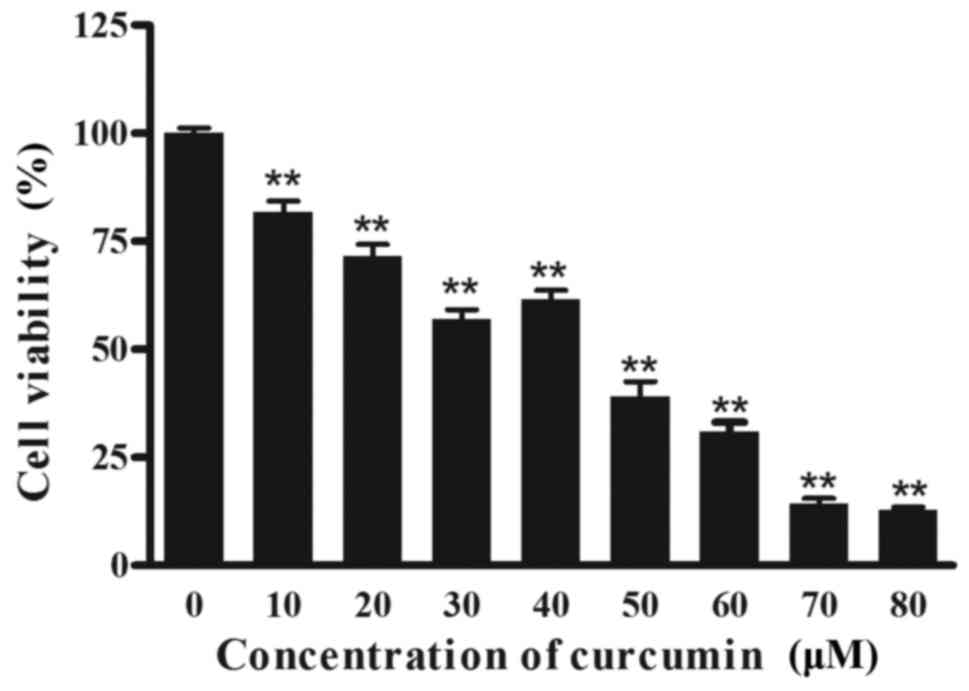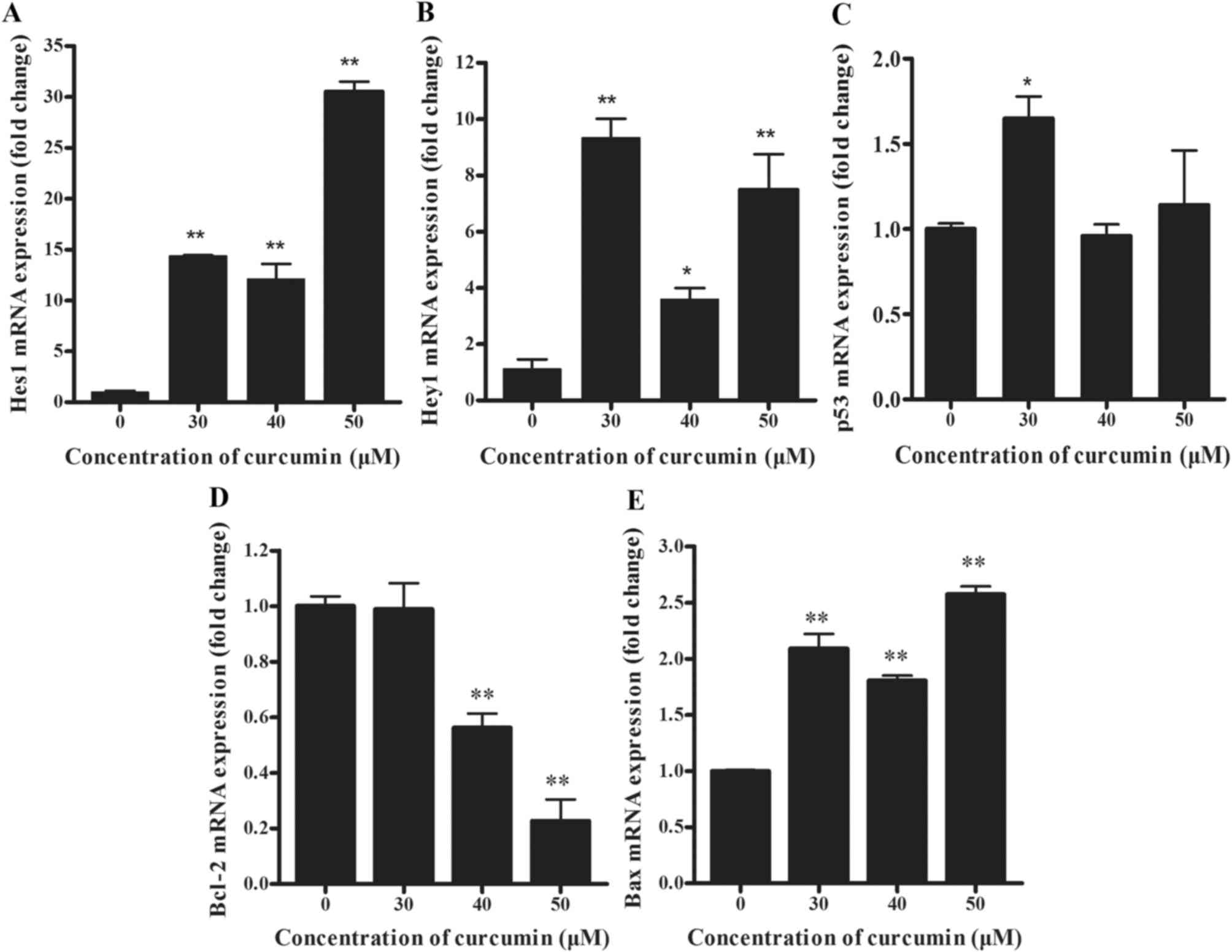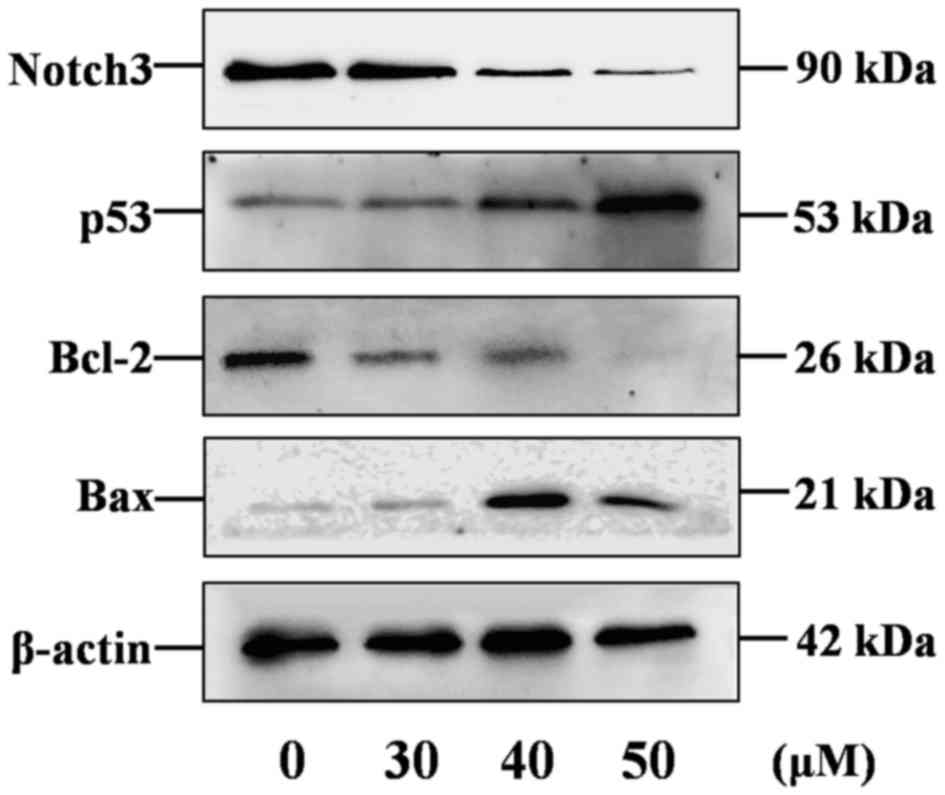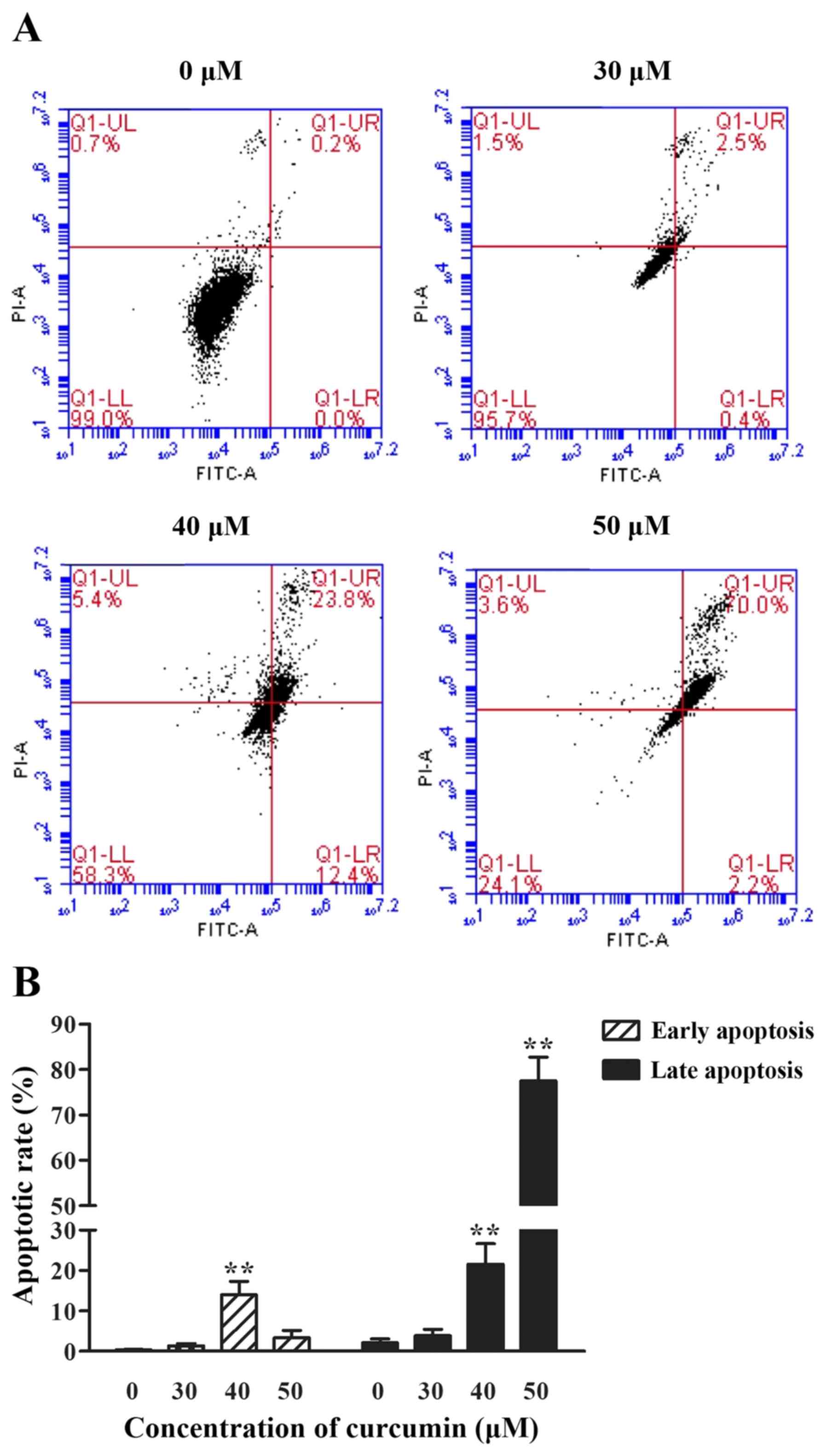|
1
|
Zhang X, Wang R, Chen G, Dejean L and Chen
QH: The Effects of curcumin-based compounds on proliferation and
cell death in cervical cancer cells. Anticancer Res. 35:5293–5298.
2015.PubMed/NCBI
|
|
2
|
Hu A, Huang JJ, Li RL, Lu ZY, Duan JL, Xu
WH, Chen XP and Fan JP: Curcumin as therapeutics for the treatment
of head and neck squamous cell carcinoma by activating SIRT1. Sci
Rep. 5:134292015. View Article : Google Scholar : PubMed/NCBI
|
|
3
|
Balakrishna A and Kumar MH: Evaluation of
synergetic anticancer activity of berberine and curcumin on
different models of A549, Hep-G2, MCF-7, jurkat, and K562 cell
lines. Biomed Res Int. 2015:3546142015. View Article : Google Scholar : PubMed/NCBI
|
|
4
|
Ting CY, Wang HE, Yu CC, Liu HC, Liu YC
and Chiang IT: Curcumin triggers DNA damage and inhibits expression
of DNA repair proteins in human lung cancer cells. Anticancer Res.
35:3867–3873. 2015.PubMed/NCBI
|
|
5
|
Mukhopadhyay A, Banerjee S, Stafford LJ,
Xia C, Liu M and Aggarwal BB: Curcumin-induced suppression of cell
proliferation correlates with down-regulation of cyclin D1
expression and CDK4-mediated retinoblastoma protein
phosphorylation. Oncogene. 21:8852–8861. 2002. View Article : Google Scholar : PubMed/NCBI
|
|
6
|
Li ZC, Zhang LM, Wang HB, Ma JX and Sun
JZ: Curcumin inhibits lung cancer progression and metastasis
through induction of FOXO1. Tumour Biol. 35:111–116. 2014.
View Article : Google Scholar : PubMed/NCBI
|
|
7
|
Choudhuri T, Pal S, Agwarwal ML, Das T and
Sa G: Curcumin induces apoptosis in human breast cancer cells
through p53-dependent Bax induction. FEBS Lett. 512:334–340. 2002.
View Article : Google Scholar : PubMed/NCBI
|
|
8
|
Wang L, Wang L, Song R, Shen Y, Sun Y, Gu
Y, Shu Y and Xu Q: Targeting sarcoplasmic/endoplasmic reticulum
Ca2+-ATPase 2 by curcumin induces ER stress-associated
apoptosis for treating human liposarcoma. Mol Cancer Ther.
10:461–471. 2011. View Article : Google Scholar : PubMed/NCBI
|
|
9
|
Chang PY, Peng SF, Lee CY, Lu CC, Tsai SC,
Shieh TM, Wu TS, Tu MG, Chen MY and Yang JS: Curcumin-loaded
nanoparticles induce apoptotic cell death through regulation of the
function of MDR1 and reactive oxygen species in cisplatin-resistant
CAR human oral cancer cells. Int J Oncol. 43:1141–1150. 2013.
View Article : Google Scholar : PubMed/NCBI
|
|
10
|
Rashmi R, Santhosh Kumar TR and
Karunagaran D: Human colon cancer cells differ in their sensitivity
to curcumin-induced apoptosis and heat shock protects them by
inhibiting the release of apoptosis-inducing factor and caspases.
FEBS Lett. 538:19–24. 2003. View Article : Google Scholar : PubMed/NCBI
|
|
11
|
Raab MS, Podar K, Breitkreutz I,
Richardson PG and Anderson KC: Multiple myeloma. Lancet.
374:324–339. 2009. View Article : Google Scholar : PubMed/NCBI
|
|
12
|
Delgado-Calle J, Anderson J, Cregor MD,
Hiasa M, Chirgwin JM, Carlesso N, Yoneda T, Mohammad KS, Plotkin
LI, Roodman GD and Bellido T: Bidirectional notch signaling and
osteocyte-derived factors in the bone marrow microenvironment
promote tumor cell proliferation and bone destruction in multiple
myeloma. Cancer Res. 76:1089–1100. 2016. View Article : Google Scholar : PubMed/NCBI
|
|
13
|
Terpos E, Ntanasis-Stathopoulos I,
Gavriatopoulou M and Dimopoulos MA: Pathogenesis of bone disease in
multiple myeloma: From bench to bedside. Blood Cancer J. 8:72018.
View Article : Google Scholar : PubMed/NCBI
|
|
14
|
Jundt F, Pröbsting KS, Anagnostopoulos I,
Muehlinghaus G, Chatterjee M, Mathas S, Bargou RC, Manz R, Stein H
and Dörken B: Jagged1-induced notch signaling drives proliferation
of multiple myeloma cells. Blood. 103:3511–3515. 2004. View Article : Google Scholar : PubMed/NCBI
|
|
15
|
Artavanis-Tsakonas S, Rand MD and Lake RJ:
Notch signaling: Cell fate control and signal integration in
development. Science. 284:770–776. 1999. View Article : Google Scholar : PubMed/NCBI
|
|
16
|
Park JT, Chen X, Tropè CG, Davidson B,
Shih IeM and Wang TL: Notch3 overexpression is related to the
recurrence of ovarian cancer and confers resistance to carboplatin.
Am J Pathol. 177:1087–1094. 2010. View Article : Google Scholar : PubMed/NCBI
|
|
17
|
Dang T, Vo K, Washington K and Berlin J:
The role of Notch3 signaling pathway in pancreatic cancer. J Clin
Oncol. 25:21049. 2007.
|
|
18
|
Zhang H, Liu L, Liu C, Pan J, Lu G, Zhou
Z, Chen Z and Qian C: Notch3 overexpression enhances progression
and chemoresistance of urothelial carcinoma. Oncotarget.
8:34362–34373. 2017.PubMed/NCBI
|
|
19
|
Gramantieri L, Giovannini C, Lanzi A,
Chieco P, Ravaioli M, Venturi A, Grazi GL and Bolondi L: Aberrant
Notch3 and Notch4 expression in human hepatocellular carcinoma.
Liver Int. 27:997–1007. 2007. View Article : Google Scholar : PubMed/NCBI
|
|
20
|
Konishi J, Kawaguchi KS, Vo H, Haruki N,
Gonzalez A, Carbone DP and Dang TP: Gamma-secretase inhibitor
prevents Notch3 activation and reduces proliferation in human lung
cancers. Cancer Res. 67:8051–8057. 2007. View Article : Google Scholar : PubMed/NCBI
|
|
21
|
Bellavia D, Campese AF, Checquolo S,
Balestri A, Biondi A, Cazzaniga G, Lendahl U, Fehling HJ, Hayday
AC, Frati L, et al: Combined expression of pTalpha and Notch3 in T
cell leukemia identifies the requirement of preTCR for
leukemogenesis. Proc Natl Acad Sci USA. 99:3788–3793. 2002.
View Article : Google Scholar : PubMed/NCBI
|
|
22
|
Iso T, Kedes L and Hamamori Y: HES and
HERP families: Multiple effectors of the Notch signaling pathway. J
Cell Physiol. 194:237–255. 2003. View Article : Google Scholar : PubMed/NCBI
|
|
23
|
Kruiswijk F, Labuschagne CF and Vousden
KH: p53 in survival, death and metabolic health: A lifeguard with a
licence to kill. Nat Rev Mol Cell Biol. 16:393–405. 2015.
View Article : Google Scholar : PubMed/NCBI
|
|
24
|
Giovannini C, Minguzzi M, Baglioni M,
Fornari F, Giannone F, Ravaioli M, Cescon M, Chieco P, Bolondi L
and Gramantieri L: Suppression of p53 by Notch3 is mediated by
Cyclin G1 and sustained by MDM2 and miR-221 axis in hepatocellular
carcinoma. Oncotarget. 5:10607–10620. 2014. View Article : Google Scholar : PubMed/NCBI
|
|
25
|
Hasty P, Campisi J and Sharp ZD: Do p53
stress responses impact organismal aging? Transl Cancer Res.
5:685–691. 2016. View Article : Google Scholar
|
|
26
|
Chipuk JE, Kuwana T, Bouchier-Hayes L,
Droin NM, Newmeyer DD, Schuler M and Green DR: Direct activation of
Bax by p53 mediates mitochondrial membrane permeabilization and
apoptosis. Science. 303:1010–1014. 2004. View Article : Google Scholar : PubMed/NCBI
|
|
27
|
Czabotar PE, Lessene G, Strasser A and
Adams JM: Control of apoptosis by the BCL-2 protein family:
Implications for physiology and therapy. Nat Rev Mol Cell Biol.
15:49–63. 2014. View
Article : Google Scholar : PubMed/NCBI
|
|
28
|
Subramaniam D, Ponnurangam S, Ramamoorthy
P, Standing D, Battafarano RJ, Anant S and Sharma P: Curcumin
induces cell death in esophageal cancer cells through modulating
notch signaling. PLoS One. 7:e305902012. View Article : Google Scholar : PubMed/NCBI
|
|
29
|
Livak KJ and Schmittgen TD: Analysis of
relative gene expression data using real-time quantitative PCR and
the 2(-Delta Delta C(T)) method. Methods. 25:402–408. 2001.
View Article : Google Scholar : PubMed/NCBI
|
|
30
|
Igney FH and Krammer PH: Death and
anti-death: Tumour resistance to apoptosis. Nat Rev Cancer.
2:277–288. 2002. View
Article : Google Scholar : PubMed/NCBI
|
|
31
|
Ammon HP and Wahl MA: Pharmacology of
curcuma longa. Planta Med. 57:1–7. 1991. View Article : Google Scholar : PubMed/NCBI
|
|
32
|
Zhang L, Cheng X, Gao Y, Bao J, Guan H, Lu
R, Yu H, Xu Q and Sun Y: Induction of ROS-independent DNA damage by
curcumin leads to G2/M cell cycle arrest and apoptosis in human
papillary thyroid carcinoma BCPAP cells. Food Funct. 7:315–325.
2016. View Article : Google Scholar : PubMed/NCBI
|
|
33
|
Bhullar KS, Jha A and Rupasinghe HP: Novel
carbocyclic curcumin analog CUR3d modulates genes involved in
multiple apoptosis pathways in human hepatocellular carcinoma
cells. Chem Biol Interact. 242:107–122. 2015. View Article : Google Scholar : PubMed/NCBI
|
|
34
|
Gali-Muhtasib H, Hmadi R, Kareh M, Tohme R
and Darwiche N: Cell death mechanisms of plant-derived anticancer
drugs: Beyond apoptosis. Apoptosis. 20:1531–1562. 2015. View Article : Google Scholar : PubMed/NCBI
|
|
35
|
Bellavia D, Campese AF, Alesse E, Vacca A,
Felli MP, Balestri A, Stoppacciaro A, Tiveron C, Tatangelo L,
Giovarelli M, et al: Constitutive activation of NF-kappaB and
T-cell leukemia/lymphoma in Notch3 transgenic mice. EMBO J.
19:3337–3348. 2000. View Article : Google Scholar : PubMed/NCBI
|
|
36
|
Turner N, Lambros MB, Horlings HM, Pearson
A, Sharpe R, Natrajan R, Geyer FC, van Kouwenhove M, Kreike B,
Mackay A, et al: Integrative molecular profiling of triple negative
breast cancers identifies amplicon drivers and potential
therapeutic targets. Oncogene. 29:2013–2023. 2010. View Article : Google Scholar : PubMed/NCBI
|
|
37
|
Pedrosa AR, Graça JL, Carvalho S,
Peleteiro MC, Duarte A and Trindade A: Notch signaling dynamics in
the adult healthy prostate and in prostatic tumor development.
Prostate. 76:80–96. 2016. View Article : Google Scholar : PubMed/NCBI
|
|
38
|
Sansone P, Storci G, Giovannini C,
Pandolfi S, Pianetti S, Taffurelli M, Santini D, Ceccarelli C,
Chieco P and Bonafé M: p66Shc/Notch-3 interplay controls
self-renewal and hypoxia survival in human stem/progenitor cells of
the mammary gland expanded in vitro as mammospheres. Stem Cells.
25:807–815. 2007. View Article : Google Scholar : PubMed/NCBI
|
|
39
|
Bieging KT, Mello SS and Attardi LD:
Unravelling mechanisms of p53-mediated tumour suppression. Nat Rev
Cancer. 14:359–370. 2014. View Article : Google Scholar : PubMed/NCBI
|
|
40
|
Giovannini C, Gramantieri L, Chieco P,
Minguzzi M, Lago F, Pianetti S, Ramazzotti E, Marcu KB and Bolondi
L: Selective ablation of Notch3 in HCC enhances doxorubicin's death
promoting effect by a p53 dependent mechanism. J Hepatol.
50:969–979. 2009. View Article : Google Scholar : PubMed/NCBI
|
|
41
|
Zhu W, Liang Q, Yang X, Yu Y, Shen X and
Sun G: Combination of sorafenib and Valproic acid synergistically
induces cell apoptosis and inhibits hepatocellular carcinoma growth
via down-regulating Notch3 and pAkt. Am J Cancer Res. 7:2503–2514.
2017.PubMed/NCBI
|
|
42
|
Chakraborty S, Das K, Saha S, Mazumdar M,
Manna A, Chakraborty S, Mukherjee S, Khan P, Adhikary A, Mohanty S,
et al: Nuclear matrix protein SMAR1 represses c-Fos-mediated HPV18
E6 transcription through alteration of chromatin histone
deacetylation. J Biol Chem. 289:29074–29085. 2014. View Article : Google Scholar : PubMed/NCBI
|
|
43
|
Song Y, Zhang Y, Jiang H, Zhu Y, Liu L,
Feng W, Yang L, Wang Y and Li M: Activation of Notch3 promotes
pulmonary arterial smooth muscle cells proliferation via
Hes1/p27Kip1 signaling pathway. FEBS Open Biol. 5:656–660. 2015.
View Article : Google Scholar
|
|
44
|
Zweidler-McKay PA, He Y, Xu L, Rodriguez
CG, Karnell FG, Carpenter AC, Aster JC, Allman D and Pear WS: Notch
signaling is a potent inducer of growth arrest and apoptosis in a
wide range of B-cell malignancies. Blood. 106:3898–3906. 2005.
View Article : Google Scholar : PubMed/NCBI
|
|
45
|
Zaucker A, Mercurio S, Sternheim N, Talbot
WS and Marlow FL: Notch3 is essential for oligodendrocyte
development and vascular integrity in zebrafish. Dis Model Mech.
6:1246–1259. 2013. View Article : Google Scholar : PubMed/NCBI
|
|
46
|
Haldar S, Negrini M, Monne M, Sabbioni S
and Croce CM: Down-regulation of bcl-2 by p53 in breast cancer
cells. Cancer Res. 54:2095–2097. 1994.PubMed/NCBI
|
|
47
|
Harn HJ, Ho LI, Liu CA, Liu GC, Lin FG,
Lin JJ, Chang JY and Lee WH: Down regulation of bcl-2 by p53 in
nasopharyngeal carcinoma and lack of detection of its specific
t(14;18) chromosomal translocation in fixed tissues.
Histopathology. 28:317–323. 1996. View Article : Google Scholar : PubMed/NCBI
|


















